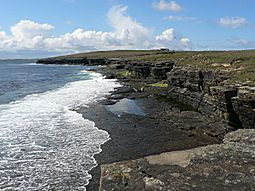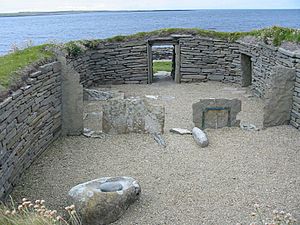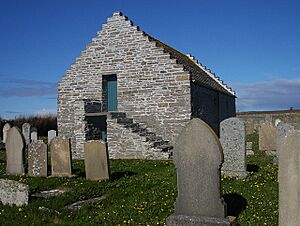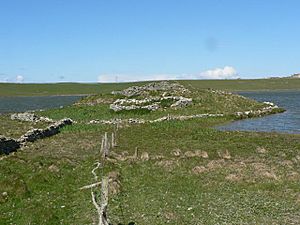Papa Westray facts for kids
| Norse name | Papey (hin) Meiri |
|---|---|
| Meaning of name | Old Norse for "big island of the papar" |
 Low cliffs on the east coast |
|
| OS grid reference | HY488518 |
| Coordinates | 59°22′N 2°54′W / 59.36°N 2.9°W |
| Physical geography | |
| Island group | Orkney |
| Area | 918 hectares (3.5 sq mi) |
| Area rank | 53 |
| Highest elevation | North Hill 49 metres (161 ft) |
| Administration | |
| Sovereign state | United Kingdom |
| Country | Scotland |
| Council area | Orkney Islands |
| Demographics | |
| Population | 90 |
| Population density | 9.8 people/km2 |
| Largest settlement | Backaskaill |

Papa Westray (Scots: Papa Westree), also called Papay, is one of the Orkney Islands in Scotland, United Kingdom. This island is known for its rich, fertile soil.
Many people visit Papa Westray to see places like Holland House, which has a folk museum. Another popular spot is the Knap of Howar, a very old farm built during the Neolithic period. Historic Scotland looks after this ancient farm.
Papa Westray is the ninth largest of the Orkney Islands. It covers an area of about 918 hectares (that's about 2,268 acres). In 2011, 90 people lived on the island. This was a good increase from 2001, when only 65 people lived there.
Contents
Getting Around Papa Westray
Orkney Ferries run boats from Papa Westray. The MV Golden Mariana sails to Gill Pier in Pierowall. Twice a week, on Tuesdays and Fridays, the MV Earl Sigurd or MV Earl Thorfinn offers a direct trip to and from Kirkwall. Kirkwall is on the Orkney Mainland. These ferries also stop at Rapness on Westray or North Ronaldsay. Sometimes, there are special boat trips on summer Sundays.
Small planes also fly from Papa Westray Airport. Loganair operates flights to Westray, North Ronaldsay, and Kirkwall. The flight from Papa Westray to Westray is super quick! It's known as the world's shortest scheduled flight, lasting only about 2 minutes.
Amazing Wildlife on Papa Westray
The northern tip of Papa Westray is called North Hill. It's the highest point on the island, reaching 49 meters (about 161 feet) high. This area is a special nature reserve run by the RSPB (Royal Society for the Protection of Birds).
Many kinds of seabirds come here to breed. You might spot Arctic terns and Arctic skuas. Papa Westray was also one of the last places where the great auk lived. Sadly, the very last great auk was killed here in 1813. The reserve is also home to a rare and tiny purple flower called the Scottish primrose.
The sea around most of Papa Westray is a special protected area. It's called a Nature Conservation Marine Protection Area. This area helps protect the feeding grounds for a bird called the black guillemot. More than 500 of these birds come to these waters each year to breed. Many of them build their nests on a small island nearby, called the Holm of Papa.
Papa Westray's Ancient History
The Knap of Howar is a very old farmstead. It was built around 3500 BC, making it the oldest preserved house in northern Europe. This ancient home has two stone rooms next to each other, connected by a door. It's partly underground and almost complete up to its roof! Pottery found here, called Unstan ware, helped experts figure out how old it is.
Long ago, in the 8th century AD, there's a story about a Pictish King named Nechtan. He wanted to marry a young woman from the island named Triduana, but she didn't want to. So, she blinded herself. Later, she became a leader of nuns in Restalrig, which is now part of Edinburgh. She was later made a saint, known as St Tredwell. A chapel was built for her on Papa Westray. People with eye problems would visit it, hoping for a cure.
Papa Westray is one of the "Papeys," which means "islands of the papar." The papar were early Christian priests. There were other "Papeys" too, like Papa Stronsay.
You can also visit the 12th-century St Boniface's Church. It has been restored and is open in summer. In its churchyard, there's a carved Norse "hogback" gravestone, also from the 12th century. This church stands on a very old Pictish religious site, possibly from the 9th century or even earlier. This site might have been where a bishop lived.
You can also see the remains of an old broch (a round stone tower) near the shore. Early Christian carved stones found here might be from as early as the 7th century AD. These stones are now in The Orkney Museum in Kirkwall and the National Museum of Scotland in Edinburgh. They might be the oldest proof of Christianity in the Northern Isles.
Another ancient place to visit is a well-preserved Neolithic chambered cairn. This is a burial mound on the small island of Holm of Papa Westray, just east of Papa Westray. This long cairn, made of local stone, was once a shared burial place for an ancient community. It has a modern roof to protect it and you can enter it from above. You can see it anytime, but you need to arrange a boat trip with the local co-op to get there.
Papa Westray was also the birthplace of John D. Mackay (1909 – 1970). He was a famous educator and writer from Orkney.
St Tredwell's Chapel
The ruins of St Tredwell's Chapel stand on a small hill. This hill is on a tiny piece of land in St Tredwell's Loch. The chapel's old walls, from the late Middle Ages, can still be seen. They were built over even older Iron Age remains. These older remains include a tunnel that leads to a round building, possibly a broch. The chapel's thick walls show it was an important and well-built place.
In 1870, Sir Henry Dryden studied the chapel. Its walls were still up to 6 feet high. The inside measured about 20 feet 3 inches by 13 feet 10 inches. Around 1880, William Traill cleared away the rubble from the chapel. He found 30 copper coins under the floor, from the time of King Charles II to King George III. He also found a female skeleton.
People believed St Tredwell could perform miracles, especially for eye problems. Pilgrims from all over Orkney and the north came to Papa Westray hoping to be cured. In 1700, a minister named John Brand wrote about the chapel. He said people would throw small stones or money onto a pile outside the chapel door as an offering. He also wrote that the loch was thought to be "medicinal." He even knew a gentleman who washed his sore eyes in the loch and became well.
Another minister, John Armit, wrote in the 19th century that people loved this old saint so much. It was hard for the first Presbyterian minister to stop them from visiting the ruins on Sunday mornings before church. People believed the saint performed wonders, curing illnesses.
See also
 In Spanish: Papa Westray para niños
In Spanish: Papa Westray para niños



